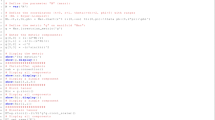Abstract
Calculations of optical devices in the geometrized Maxwell’s theory use well-known formalisms of general theory of relativity and differential geometry. In particular, for such calculations it is required to know the analytical form of the geodesic equations, which leads to the need to calculate a large number of monotonous mathematical expressions. One of the purposes of computer algebra is to facilitate the researcher’s work by automating cumbersome symbolic computations. Thus, the use of computer algebra systems seems to be quite an obvious way. Several free implementations of symbolic computations for the apparatus of general relativity are considered. A practical example of symbolic computations for the geometrized Maxwell’s theory is given.
Similar content being viewed by others
Notes
Here \(n: = n(x,y,z)\)
REFERENCES
Tamm, I.E., Electrodynamics of isotropic medium in special theory of relativity, Zh. Russk. Fiz.-Kim. Ob-va, Ser. Fiz., 1924, vol. 56, no. 2–3, pp. 248–262.
Tamm I.E., Crystallooptics of relativity theory in connection with the geometry of quadratic forms, Zh. Russk. Fiz.-Kim. Ob-va, Ser. Fiz., 1925, vol. 57, no. 3–4, pp. 209–240.
Mandelstam, L.I. and Tamm, I.Y. Elektrodynamik der anisotropen medien in der speziellen relativitätstheorie, Math. Ann., 1925, vol 95, no. 1, pp. 154–160.
Gordon, W., Zur Lichtfortpflanzung nach der Relativitätstheorie, Ann. Phys., 1923, vol. 72, pp. 421–456.
Plebanski, J., Electromagnetic waves in gravitational fields, Phys. Rev., 1960, vol. 118, no. 5, pp. 1396–1408.
Felice, F., On the gravitational field acting as an optical medium, Gen. Relativity Gravitation, 1971, vol. 2, no. 4, pp. 347–357.
Smolyaninov, I.I., Metamaterial ‘Multiverse’, J. Optics, 2011, vol. 13, no. 2, pp. 024004.
Pendry, J.B., Schurig, D., and Smith, D.R., Controlling electromagnetic fields, Science, 2006, vol. 312, no. 5781, pp. 1780–1782.
Schurig, D., Pendry, J.B., n Smith, D.R., Calculation of material properties and ray tracing in transformation media, Optics Express., 2006, vol. 14, no. 21, pp. 9794–9804.
Leonhardt, U., Optical conformal mapping, Science, 2006, vol. 312, no. June, pp. 1777–1780.
Leonhardt and U., Philbin, T.G., Transformation optics and the geometry of light, Progr. Optics, 2009, vol. 53, pp. 69–152.
Foster, R., Grant, P., Hao, Y., et al., Spatial transformations: From fundamentals to applications, Phil. Trans. Roy. Soc. A: Math., Phys. Eng. Sci., 2015, vol. 373, no. 2049, p. 20140365.
Kulyabov, D.S., Korolkova, A.V., and Sevastianov, L.A., A naive geometrization of Maxwell’s equations, 15th small triangle meeting of Theoretical Physics, Star Lesn, 2013, pp. 104–111.
Kulyabov, D.S., Korol’kova, A.V., and Sevast’yanov, L.A., A simple geometrization of Maxwell’s equations, Vestn. RUDN, Ser. Mat. Inform. Fiz., 2014, no. 2, pp. 115–125.
Kulyabov, D.S., Korolkova, A.V., Sevastianov, L.A., et al. Algorithm for lens calculations in the geometrized Maxwell theory, Saratov Fall Meeting 2017, Proc. of SPIE, 2018, vol. 10717.
Korol’kova, A.V., Kulyabov, D.S., and Sevast’yanov, L.A., Tensor Computations in Computer Algebra Systems, Program. Comput. Software, 2013, no. 3, pp. 135–142.
Kulyabov, D.S., Korol’kova, A.V., and Sevast’yanov, L.A., New features in the second version of the Cadabra computer algebra system, Program. Comput. Software, 2019, no. 2, pp. 58–64.
Sandon, D., Symbolic Computation with Python and SymPy, Independently published, 2021.
Divakov, D.V. and Tytyunnik, A.A., Symbolic investigation of the spectral characteristics of guided modes in smoothly irregular waveguides, Program. Comput. Software, 2022, no. 2, pp. 80–89.
Sympy, 2022. http://www.sympy.org/ru/index.html.
Project Jupyter, 2022. https://jupyter.org/.
Einsteinpy—Making Einstein possible in Python, 2022. https://einsteinpy-einsteinpy.readthedocs.io/en/latest/index.html.
Gravipy—Tensor calculus package for general relativity based on sympy, 2022. https://github.com/wojciechczaja/GraviPy.
Bruns, H., Das Eikonal, Leipzig: S. Hirzel, 1895, vol. 35.
Borovskikh, A.V., The two-dimensional eikonal equation, Sib. Math. J., 2006, vol. 47, pp. 813–834.
Moskalensky, E.D., Finding exact solutions to the two-dimensional eikonal equation, Num. Anal. Appl., 2009, vol. 2, pp. 201–209.
Kabanikhin, S.I. and Krivorotko, O.I., Numerical solution of eikonal equation, Sib. Elektron. Mat. Izv., 2013, vol. 10, pp. 28–34.
Kulyabov, D.S., Korolkova, A.V., Velieva, T.R., and Gevorkyan M.N., Numerical analysis of eikonal equation, Saratov Fall Meeting 2018. Proc. of SPIE, Vol. 11066, Saratov: SPIE, 2019.
Funding
This work was supported by the program of strategic academic leadership of the Peoples’ Friendship University of Russia (RUDN University).
Author information
Authors and Affiliations
Corresponding authors
Ethics declarations
The authors declare that they have no conflicts of interest.
Additional information
Translated by A. Klimontovich
Rights and permissions
About this article
Cite this article
Korol’kova, A.V., Gevorkyan, M.N., Kulyabov, D.S. et al. Computer Algebra Tools for Geometrization of Maxwell’s Equations. Program Comput Soft 49, 366–371 (2023). https://doi.org/10.1134/S0361768823020111
Received:
Revised:
Accepted:
Published:
Issue Date:
DOI: https://doi.org/10.1134/S0361768823020111



